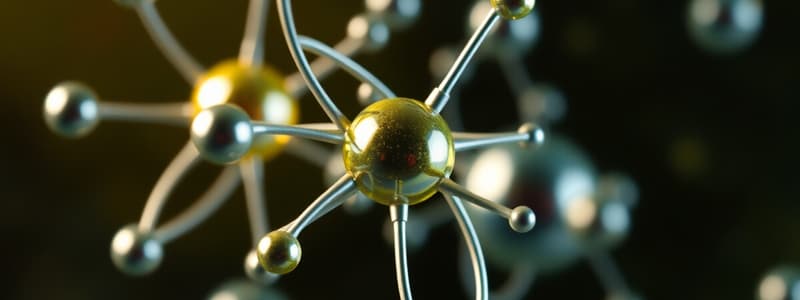Podcast
Questions and Answers
What significant aspect did the alpha scattering experiment reveal about the structure of the atom?
What significant aspect did the alpha scattering experiment reveal about the structure of the atom?
- Most of the atom's mass is concentrated in a small space at the center. (correct)
- Atoms are made up entirely of electrons and a positive charge.
- Electrons are fixed at certain distances from the nucleus.
- The nucleus contains both protons and neutrons.
Which model of the atom introduced the concept of fixed energy levels for electrons?
Which model of the atom introduced the concept of fixed energy levels for electrons?
- Dalton's Model
- Plum Pudding Model
- Nuclear Model
- Electron Shell (Bohr) Model (correct)
What was the primary limitation of Dalton's atomic model?
What was the primary limitation of Dalton's atomic model?
- It suggested electrons orbit in fixed shells.
- It effectively accounted for the presence of subatomic particles.
- It included protons and neutrons in its description.
- It depicted the atom as a solid, indivisible sphere. (correct)
How does the mass of an electron compare to that of protons and neutrons?
How does the mass of an electron compare to that of protons and neutrons?
What does the size comparison between atoms and their nuclei indicate?
What does the size comparison between atoms and their nuclei indicate?
Flashcards
Dalton's Atomic Model
Dalton's Atomic Model
John Dalton's model of the atom pictured it as a small, solid sphere that is indivisible, meaning it can't be broken down into smaller parts. It did not include protons, neutrons, or electrons.
Plum Pudding Model
Plum Pudding Model
The plum pudding model described the atom as a positively charged sphere with negatively charged electrons embedded within it, like plums in a pudding. This model was developed after the discovery of electrons but before the discovery of protons and neutrons.
Alpha Scattering Experiment
Alpha Scattering Experiment
The alpha scattering experiment involved firing positively charged alpha particles at a thin gold foil. Most particles passed straight through, but some were deflected or bounced back. This unexpected result led to the conclusion that the atom's positive charge and mass are concentrated in a small, central region called the nucleus.
Nuclear Model
Nuclear Model
Signup and view all the flashcards
Electron Shell Model
Electron Shell Model
Signup and view all the flashcards
Study Notes
Atomic Model Development
- Dalton's model: Atoms are solid, indivisible spheres. This model did not include protons, neutrons, or electrons.
- Plum Pudding Model: A cloud of positive charge with negatively charged electrons embedded within. Developed after the discovery of electrons.
- Alpha Scattering Experiment: Alpha particles were fired at a gold foil. Some were deflected, which suggested the positive charge and mass of an atom are concentrated in a small space called the nucleus.
- Nuclear Model: Replaces the plum pudding model. The atom has a dense, positively charged nucleus at the center, surrounded by orbiting electrons.
- Bohr Model: Electrons orbit the nucleus in fixed energy levels.
Subatomic Particles
- Protons: Positively charged particles, found in the nucleus.
- Neutrons: Neutral (no charge) particles, found in the nucleus.
- Electrons: Negatively charged particles, found orbiting the nucleus in shells or energy levels.
- Relative masses: Protons and neutrons have a relative mass of approximately 1, while electrons have a very small relative mass (effectively 0).
Isotopes and Atomic Number
- Isotopes: Atoms of the same element with the same number of protons but different numbers of neutrons. They have similar chemical properties but different physical properties.
- Atomic Number: The number of protons in an atom's nucleus. This number defines an element.
Nuclear Atom Structure
- Nucleus: The central, dense, positively charged part of the atom.
- Electrons: Negatively charged particles that orbit the nucleus in shells or energy levels.
- Size Comparison: Nuclei are much smaller than the atom itself. The radius of the nucleus is approximately 10,000 times smaller than the atom's radius.
Studying That Suits You
Use AI to generate personalized quizzes and flashcards to suit your learning preferences.



